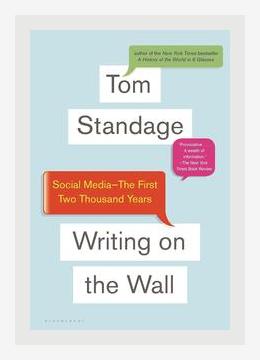Marketing and SalesSocial Media Marketing
Title: Writing on the Wall: Social Media – The First 2,000 Years
Author: Tom Standage
Category: Social Media Marketing
Summary
Introduction
“Writing on the Wall: Social Media – The First 2,000 Years” by Tom Standage examines the history of social media and its parallels with communication methods from ancient times to the present. Standage challenges the notion that social media is a recent development by drawing striking similarities between historical communication practices and modern social media platforms. This perspective provides valuable lessons for social media marketers, emphasizing that the dynamics of human connectivity and information sharing have always been integral to society.
I. The Ancient Roots of Social Media
1. The Roman Era: The First Social Network
Standage starts his exploration with Ancient Rome, illustrating how letters and written texts were shared across vast distances, much like today’s social media posts. The Roman graffiti and the correspondences among statesmen facilitated public discourse and information dissemination.
Actionable Insight: Foster community engagement.
– Action: Encourage user-generated content and discussions by creating interactive posts and prompts that invite followers to share their thoughts and experiences.
2. Martianus Capella’s Liberal Arts: Academic Social Networks
The author continues by highlighting how medieval scholars exchanged ideas through handwritten letters and book copying, forming a network similar to modern academic social platforms like ResearchGate or Academia.edu.
Actionable Insight: Nurture intellectual exchanges.
– Action: Create a knowledge-sharing community or group where professionals in your industry can share insights, studies, and best practices.
II. The Renaissance and The Printing Revolution
3. Pamphleteering: Proto-Twitter
The rise of the printing press in the 16th century revolutionized information dissemination just as Twitter or blogs do today. Martin Luther’s theses spread swiftly due to pamphlets, paving the way for social movements.
Actionable Insight: Leverage quick and impactful messaging.
– Action: Develop short, engaging content that can be easily shared and digested, such as infographics or tweet-sized facts, aligning with the attention span of modern audiences.
4. Coffeehouses: The Social Hubs of the Enlightenment
Standage draws a parallel between the intellectual exchanges in 17th-century coffeehouses and today’s social networks. These venues were breeding grounds for ideas and discussions on politics, science, and business.
Actionable Insight: Create community spaces.
– Action: Establish and manage online community groups (on platforms like Facebook or LinkedIn) where people can discuss topics relevant to your brand or field of interest.
III. The Newspaper Revolution and Beyond
5. The Spread of Newspapers: Blog Precursors
The 18th-century proliferation of newspapers resembles modern-day blogs in their role of opinion molding and information sharing. Political, social, and economic discussions were widely circulated through newspapers, similar to blog posts and articles on the internet.
Actionable Insight: Position yourself as an authority.
– Action: Regularly publish well-researched and insightful content on a blog or via social media platforms to establish thought leadership in your domain.
6. Letters to the Editor: The Original Comments Section
Standage notes that newspapers provided a platform for public opinion through “letters to the editor,” akin to comments sections on online articles and social media posts.
Actionable Insight: Engage with your audience.
– Action: Actively respond to comments and questions on your social media posts, fostering a dialogue with your audience and showing that you value their input.
IV. The Telegraph and The Birth of Real-Time Communication
7. Telegraph: The Original Instant Messaging
The advent of the telegraph in the 19th century introduced real-time, long-distance communication, serving as the precursor to modern instant messaging services.
Actionable Insight: Utilize real-time communication tools.
– Action: Implement and promote the use of real-time communication channels (like live chats or messenger bots) for customer service and engagement.
V. The Modern Day: The Resurgence of Social
8. Social Media Evolution: A Continuum
Standage argues that modern social media is a natural evolution of historical communication practices. Platforms like Facebook, Twitter, Instagram, and others have merely amplified the reach and speed of information sharing.
Actionable Insight: Adapt to evolving platforms.
– Action: Stay updated with the latest social media trends and functionalities to leverage new features and engagement tools as they become available.
9. Viral Spread: The Power of Networks
Historical examples include how ideas like Joseph Schumpeter’s “creative destruction” spread through networks, comparable to the viral spread of modern memes or videos.
Actionable Insight: Create shareable content.
– Action: Produce compelling, shareable content that resonates emotionally or intellectually with your audience, encouraging them to spread it within their networks.
10. Data and Privacy: Historical Lessons
Drawing from the past, Standage discusses the importance of privacy and data integrity. Historical misuse of information by state powers serves as a caution for modern data practices.
Actionable Insight: Prioritize data privacy.
– Action: Ensure transparency about data collection and usage practices, and implement strong security measures to protect user data.
Conclusion
“Writing on the Wall” demonstrates that while the tools and technologies of communication have evolved, the core principles of human interaction through shared content have remained constant. Whether it’s letters between scholars, pamphlets spreading revolutionary ideas, or social media posts fostering global movements, the essence of social media marketing lies in understanding the timeless human desire to connect, share, and influence.
Final Actionable Insight: Embrace the historical lessons.
– Action: Apply ancient communication principles—community building, intellectual exchange, real-time engagement, and responsible data use—to modern social media marketing practices to create a more effective and sustainable online presence.
By recognizing that social media is part of a long tradition of human communication, marketers can draw on timeless strategies to enhance connectivity and impact through their campaigns.
